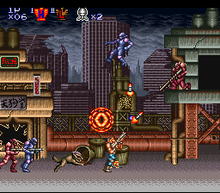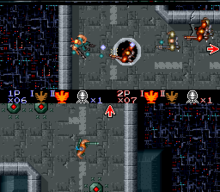- Contra III: The Alien Wars
-
Contra III: The Alien Wars 
Cover artDeveloper(s) Konami Publisher(s) Konami Designer(s) Nobuya Nakazato Composer(s) Miki Higashino[1]
Masanori Adachi[1]
Tappy Iwase[1]Platform(s) Super Nintendo Entertainment System
Game Boy
Game Boy Advance
Nintendo Super System
Virtual ConsoleRelease date(s) Super Nintendo
- JP February 28, 1992
- NA April 6, 1992
- EU November 19, 1992
- NA November 3, 2002
- JP November 14, 2002
- EU February 21, 2003
- NA January 29, 2007
Genre(s) Run and gun Mode(s) Single-player, cooperative Rating(s) Game Boy Advance:
ESRB: Everyone
CERO: All Ages
ELSPA: 11++
Virtual Console
ESRB: Everyone 10+Media/distribution 16-Megabit cartridge (SNES)
32-Megabit cartridge (GBA)Contra III: The Alien Wars, released in Japan as Contra Spirits (魂斗羅スピリッツ) and in the PAL region as Super Probotector: Alien Rebels, is a 1992 run and gun game for the Super Nintendo Entertainment System produced by Konami. It is the third console iteration of the Contra series, following the original Contra and Super C for the NES.
Contents
Plot
Set in the futuristic year 2636, the alien invaders that were defeated during the previous installments have decided to launch a full-scale war against mankind on Earth, starting the "Alien Wars". Unlike the previous Contra games for the NES and Game Boy, the futuristic setting was kept for the American version. However, the identities of "Bill" and "Lance", the original Contra heroes, were changed to their descendants "Jimbo" and "Sully", maintaining the continuity of the previous localizations. Likewise, the alien invader was once again changed to "Red Falcon".
Gameplay
Taking advantage of the technology provided by the Super NES, the graphics in Contra III improved upon the NES versions of the first two installments, bringing it closer to the quality of their arcade counterparts. The level design is more complex, and provides more opportunity for interaction. For instance, players can grab on to poles or ceilings and navigate them in a monkey bar fashion, climb walls and ladders, destroy buildings and scenery, and commandeer tanks.
New styles of levels in The Alien Wars involve motorcycle chases, riding on missiles, and two Mode 7 enabled top-view levels. The weapons system is revamped, and players can carry two weapons instead of one, only losing the one they are currently using if they die. They can also fire these two weapons simultaneously in a spin-jump circular fire pattern that hit enemies on all sides: however, being hit while doing so results in the player losing both of their weapons. The player can also lock their character's mobility, allowing the player to shoot at all eight possible directions (including downwards and at angles) without moving or jumping. Finally, the player's default gun now has autofire capability (as a result, the Machine Gun from previous installments is gone). New weapons includes a whip-style Flame Gun, Crusher Missiles, and Homing Missiles similar to the Hunter Gun in Operation C. The player can also carry Bombs which will destroy almost all on-screen enemies when detonated at any time.
Top-view stages
There are two top-view stages in the game: Stage 2 (the Collapsed Highway) and Stage 5 (the Steep Cliffs). The controls in the top-view stages differ from those in Super Contra and Operation C. The player's character always faces the same direction when moved with the control pad and must be rotated with the shoulder buttons (L and R). The perspective differs depending on which game mode is played. When these stages are played in 1-Player Mode, the character always faces up and the area rotates around him. In 2 Players A Mode, these stages uses a horizontal split-screen format, with the first player's half of the screen on the top and second player's half on the bottom. Both characters face right in this mode. In 2-Players B Mode, both players share the same screen and their characters rotate while the perspective remains fixed for both players.
The objective in these stages is also different from the standard side-view stages. Rather than moving into a linear path towards the end of the stage to face a stage boss, the player must first destroy a series of targets situated at fixed locations. The player may select his landing point at the start of the stage, while on-screen arrows help the player lead his character to the nearest target (a map can also be used that pinpoints the player's current location while showing the remaining targets). After all targets are destroyed, the player is transported to a new area to face the boss.
Lives, continues and cheat codes
In the North American and PAL versions of the game, there is no cheat code that extends the amount of lives. Instead, the player can select the number of lives to start with - three, five, or seven are the available choices. The amount of continues is adjusted according to the difficulty level (which also determines the durability of enemies). The Japanese version, however, does contain a 30-lives cheat and the player has unlimited continues regardless of difficulty. There are also cheat codes that allow the player to choose the stage and have access to a sound test mode. The maximum amount of lives that a player is able to obtain is capped at thirty.
Difficulty and ending
There are three levels of difficulty in the game - Easy, Normal, and Hard. Each increase in difficulty setting also alters several aspects of the game. For example, enemy bosses, when fought on harder difficulties, will have new attacks or modifications to their already-existing attacks patterns. Also, some situations in the game, such as flying in the air on missiles, become more difficult, as the missiles will travel much faster on higher difficulties. In addition, some objects and boss weak points that were destructible on easier difficulty levels will become indestructible on Normal or Hard mode.
If the player completes the game on Easy or Normal, then he will start at the very first stage on the next difficulty with his current weapon configuration, lives, and score intact. On the Hard setting, the final boss will have an additional form that the player must defeat as they escape from the Alien Lair. After defeating this form, the true ending will be shown, followed by the credits and then the player's final score.
Development
The game's tentative title in North America was Super Contra IV.[2] This was presumably because Contra Force, an unrelated NES game by Konami, was originally intended to be the series' third console installment.[3]
The Japanese version, titled Contra Spirits, features three cheat codes that were removed from the overseas releases: a thirty lives code, a stage select, and a sound test. The Japanese version also features unlimited continues, regardless of the difficulty setting, whereas the number of times the player can continue in the overseas versions varies between difficulty settings.
The PAL version, Super Probotector: Alien Rebels, is identical to the American release in terms of difficulty, but replaces the original commandos with robotic soldiers codenamed RD008 and RC011.
Ports
Game Boy
In 1994, a Game Boy port was released simply titled Contra: The Alien Wars in North America (dropping the numeral from the game's title), as Contra Spirits in Japan, and as Probotector 2 in Europe and Australia (following up on the Probotector localization of Operation C). The port was developed by German developer Factor 5. In this version, the level structure had been altered, many of the enemy bosses were removed, and Stage 4 of the original game (the Air Battle level) was removed. A strafing ability was included to compensate for the absence of rotation in both top-view stages, and a password feature was added. The player no longer has the ability to hold two weapons, but can still carry and use Bombs with the Select button. All the weapons from the original SNES game are featured except for the Laser Gun. The game features Super Game Boy support, which provides a custom color scheme and enhanced sound effects.
Game Boy Advance
Konami released a second portable version of Contra III in 2002 for the Game Boy Advance titled Contra Advance: The Alien Wars EX, which was released in Japan as Contra: Hard Spirits (魂斗羅 ハードスピリッツ). Unlike the original SNES game and the previous Game Boy adaptation, Contra Advance was released in Europe and Australia under the Contra name without the Probotector title and robotic characters. The designers made changes to many of the features of the original game. The mega bombs and the ability to wield two weapons were removed, but the player can now lock their character's aim like in Contra: Shattered Soldier (allowing the player to move anywhere while shooting at one direction) and is given a choice to revert back to their previously held weapon when picking a new one. The top-view stages (Stage 2 and 5) from the original SNES game were replaced with two stages from Contra: Hard Corps (the Military Train and Big Battle stages).
Other releases
Contra III was one of a few select titles for the Nintendo Super System, an arcade system which was used to preview Super NES games in North America. Players insert credits to buy time which allows them to pick and choose from a list of available games to play. The game is identical to the Super NES version.
The original Super NES game was also released as part of the Wii's Virtual Console lineup on January, 2007 in all three territories (Japan, North America and the PAL region).[4][5][6]
Reception
- Gameranking: 88.58%
- IGN: 8/10[7]
- Nintendo Power: 4.225/5
- Cubed3: 9.1/10[8]
- Electronic Gaming Monthly: 9/10
- GF3K: 9.6/10
- PGNx Media: 9/10
- Netjak: 9/10
References
- ^ a b c Composer information at SNES Music
- ^ The Contra HQ: Super Contra IV, from the Nintendo Player's Guide: Super NES, pg. 152. Retrieved on August 13, 2007.
- ^ "Pak Watch: From Konami/Ultra". Nintendo Power (Volume 26): p. 95. July 1991. "As for sequels, look for Contra Force (aka Contra 3) and Teenage Mutant Ninja Turtles 3 sometime this winter"
- ^ "VC魂斗羅スピリッツ" (in Japanese). http://www.nintendo.co.jp/wii/vc/vc_cs/index.html.
- ^ "Nintendo - Games - Super Probotector: Alien Rebels". http://www.nintendo.co.uk/NOE/en_GB/games/vc/super_probotector_alien_rebels_1845.html.
- ^ "Nintendo :: Wii :: Virtual Console :: Games :: Contra III: The Alien Wars". http://www.nintendo.com/wii/virtualconsole/games/detail/c5Nka0CG0jZLsS9d1y5QCD3dmQsroRit.
- ^ http://retro.ign.com/articles/863/863185p1.html
- ^ http://www.cubed3.com/review/191/
External links
- GameFAQs entry for Contra III: The Alien Wars (SNES)
- Complete videowalkthrough from Contra 3 at archive.org
- Contra III: The Alien Wars at MobyGames
- Contra Spirits at superfamicom.org
- 魂斗羅スピリッツ / Contra Spirits at super-famicom.jp (Japanese)
Contra series Contra · Super Contra · Operation C · Contra III: The Alien Wars · Contra Force · Contra: Hard Corps · Contra: Legacy of War · C: The Contra Adventure · Contra: Shattered Soldier · Neo Contra · Contra 4 · Contra ReBirth · Hard Corps: UprisingCategories:- 1992 video games
- Konami games
- Super Nintendo Entertainment System games
- Game Boy games
- Game Boy Advance games
- Virtual Console games
- Contra (series)
- Run and gun games
- Post-apocalyptic video games
- Video game sequels
Wikimedia Foundation. 2010.


